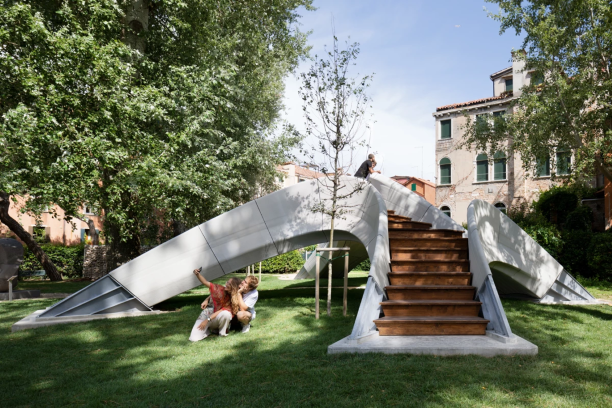A freestanding, unreinforced bridge for pedestrians made from 3D-printed concrete blocks opened in Venice, Italy.
They named it Striatus. Though, it doesn’t carry pedestrians over any of the city’s famed Venice canals. This first-of-its-kind structure opened at the Giardino Della Marinaressa during the run of the 2021 Venice Architecture Biennale.

Who built Striatus?
ETH Zürich’s Block Research Group collaborated the Zaha Hadid Architects Computation and Design Group (ZHACODE) and the Incremental3D company. Concrete ink developed by Holcim made the project possible.
“This precise method of 3D concrete printing allows us to combine the principles of traditional vaulted construction with digital concrete fabrication to use material only where it is structurally necessary without producing waste,” explains Philippe Block, a scientist from ETH Zurich.
According to Zaha Hadid Architects, the current construction project is a blend of ancient architectural practices and contemporary computational design. The name “Striatus” is a reference to the structural logic of the construction process. Engineers made the bridge from dried pieces and constructed it through additional layers of unreinforced concrete.
What is an unreinforced concrete bridge hard?
Civil engineers love concrete because it is versatile and inexpensive. Concrete has great strength in compression. However, low tensile strength means large concrete structures lose strength easily.
Basically, you can think of tensile strength as an ability to resist stretching. For example, if you have a long, thin concrete beam, any attempt to “snap” that beam, or perhaps twist it, would be a test of its tensile strength.
Concrete’s low tensile strength means the real construction often needs to add steel rebar or other material to the concrete. However, these materials make complex 3D printing impossible.
Old Tech Meets New Tech in Italy
“Striatus stands on the shoulders of giants: it revives ancestral techniques of the past, taking the structural logic of the 1600s into the future with digital computation, engineering and robotic manufacturing technologies,” said Bhooshan, a researcher at Zaha Hadid Architects.
The 12 by 16-metre pedestrian bridge is real architecture in every sense. Critically, the bridge allows researchers at the ETH Zürich to demonstrate the real potential of 3D printing for use on load-bearing, unreinforced concrete structures.
Conveniently, if the bridge is no longer needed in the future, the assembly method could disassemble the structure and reassemble it in a different place or recycle it. The structure is currently located at the Giardini Della Marinaressa as part of the Venice Architecture Biennale. The bridge will remain there until November 2021.
What to Read Next



